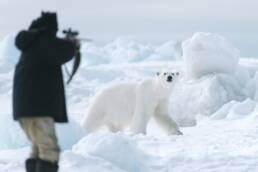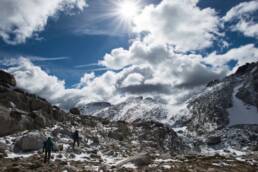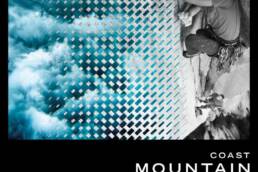From the icy edge of the Arctic Ocean to the heated protests at Standing Rock, North Dakota, an indigenous photographer attempts to understand the relationship between mankind and land, from multiple perspectives. Story and photos by Kiliii Yüyan.
It was around midnight when the polar bear was killed. I was watching a teal blue iceberg float across a dark expanse of saltwater. Standing on the sea ice kilometres off Alaska’s coastline, I was lost in thought, floating in the hypnotic rhythm of icebergs.
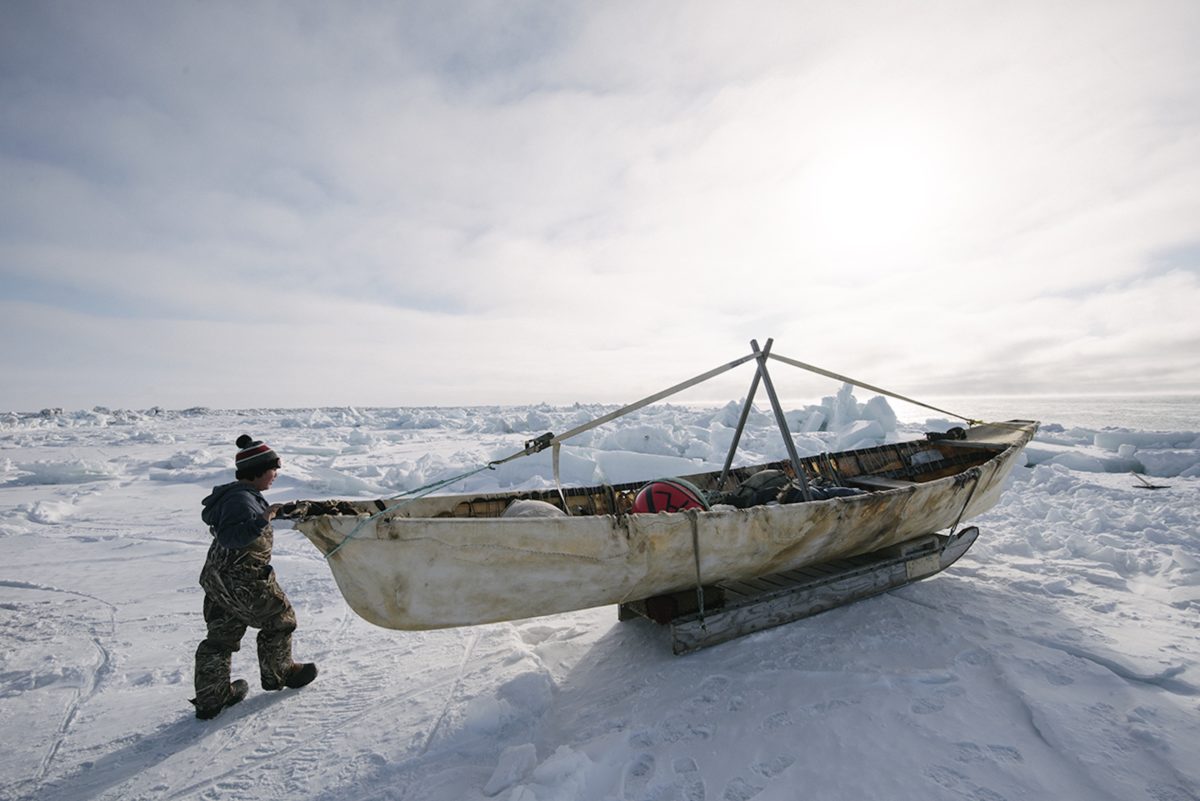
“Nanuq! Nanuq!”, rang out in the cold Arctic air. Polar bear.
I felt the fearful stiffening of the Iñupiaq hunters around me, all raised in this land of sudden death. The bear’s massive frame rose from behind a boulder of ice as if performing a slow push-up. Its face remained calm and implacable, and I knew that we had been outwitted. The hunters standing beside me thought differently. Each had scattered for his rifle, and immediately there was a sharp crack and a spray of red. As swiftly as we’d been ambushed, the danger was over. The polar bear was dead. The community was safe and fed.
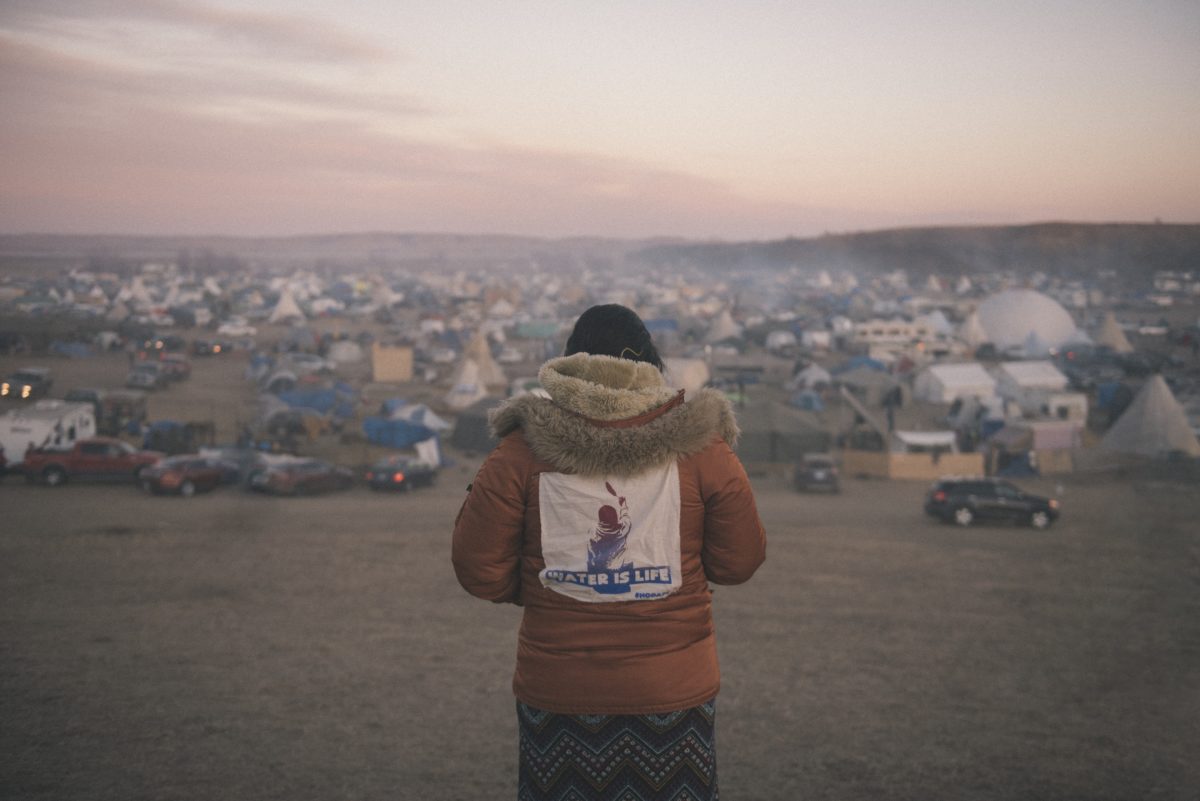
After the bear had been field-dressed and the meat sent back to the village elders, we looked for a story in its tracks. Having crawled out of the sea downwind from us, it had crept about seeking stragglers. Two hunters had walked away for a few minutes while repairing a snowmobile. When they rejoined the group, the polar bear decided to risk stalking our entire crew. But he had been spotted.
Polar bears may rule the ice, but stalking a group of ten men is an act of desperation. Broken canine teeth revealed the motive for such a brash move—the bear was starving. As vanishing Arctic ice depleted his hunting grounds, the great predator had succumbed to the emergency instincts that have increasingly led his species into losing battles.
Some believe the culture of living close to the land is a privilege we can no longer afford. Like spoiled children that have broken all our own toys, both sides believe they deserve the remaining toys.
Shooting a polar bear causes great controversy outside of most Arctic communities. Most people are appalled at the death of such a beautiful, charismatic animal. At the heart of this divide is a cultural tension. It is the social and political animosity currently seething in much of the western world.
The fundamental difference which is missing from the mainstream debate, is how each side sees the land. To some, the land is a bounty of infinite resources; it exists to support one’s family and community. To others, the land is a scenic wilderness to be preserved like a museum and used solely for recreation. These deep-seated attitudes toward the land are as opposed as they are shortsighted.
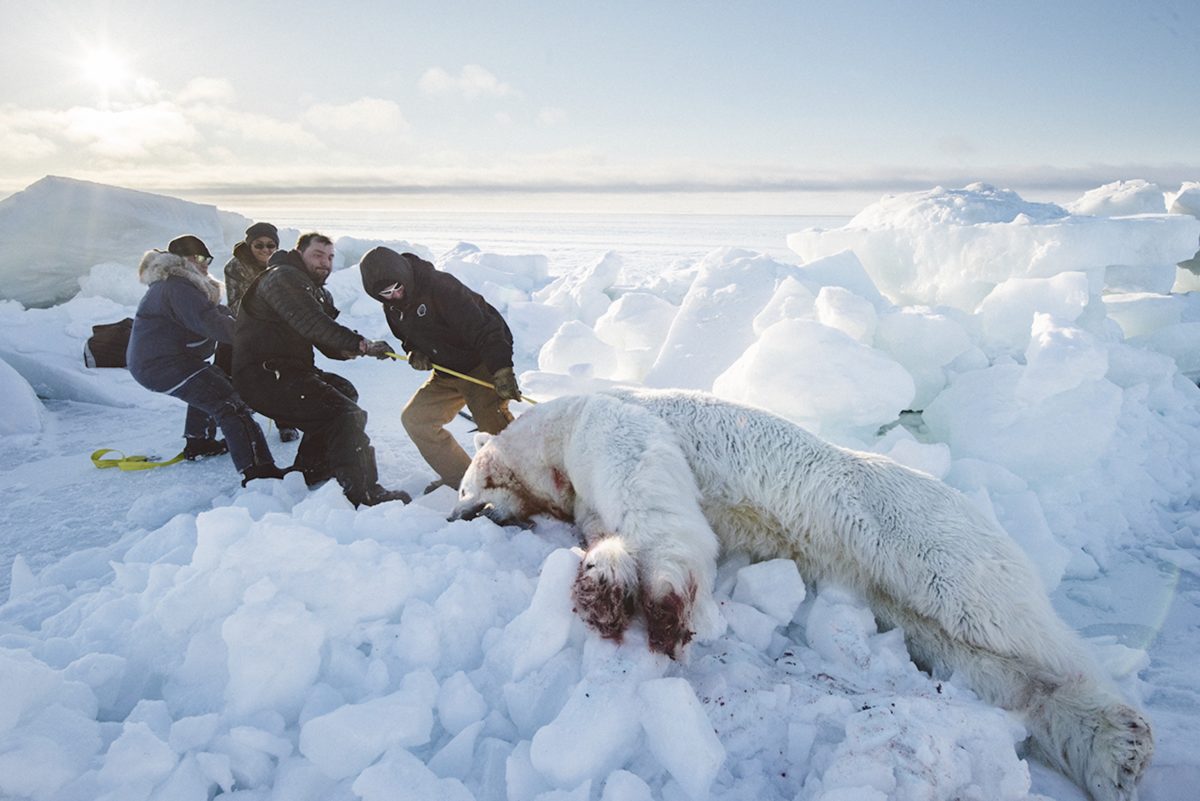
Until recently, the Iñupiats of Alaska were not plagued by this polarization. They treated their land with respect and it provided in return. The Iñupiat spent a thousand years developing a reverence for the polar bear. Shooting a polar bear is not controversial to them. The equation is simple and pragmatic—shoot first, or be eaten. This simplicity belies Iñupiaq cultural attitudes that govern the act of shooting a polar bear. This relationship can be a mystery to those who don’t live in an ever-changing, icy landscape where life is difficult.
During spring whaling, hungry bears come to the butchering area in droves—I counted as many as thirteen in one day—drawn to the scent of fresh whale. At times, when a nanuq tries to nab some whale meat, Iñupiat often cry out, “Let him eat.” This respectful co-existence lasts if the bears keep their distance. When a bear gets too close, out of desperation, a hunter feels forced to shoot to kill.
Polar bears may rule the ice, but stalking a group of ten men is an act of desperation. Broken canine teeth revealed the motive for such a brash move—the bear was starving.
Many indigenous cultures see no conflict between reverence for the animal and eating it. Mongolian sheepherders revere the wolf as a cunning and powerful being, but they also must fight wolves during the grazing season. Every night brings an epic battle between the sheep herder and the wolf. For many, this seems inefficient. Why not regulate the population with recurring culls from a helicopter, as the British Columbian government does? On the other hand, conservationists call for a complete ban on shooting wolves. How could we kill such a noble creature?
The relationship between indigenous communities and animals evokes a romantic primitivism known to anthropologists as the noble savage theory. It is a stereotype of a docile and spiritual people, at one with the natural world. Though history textbooks have begun correcting this misguided narrative, perspectives are harder to shift. Indigenous attitudes and management of the land are complex. The killing of a polar bear is complex. Such is life on the edge of understanding. The complexity only grows when indigenous rights rub up against the mainstream.
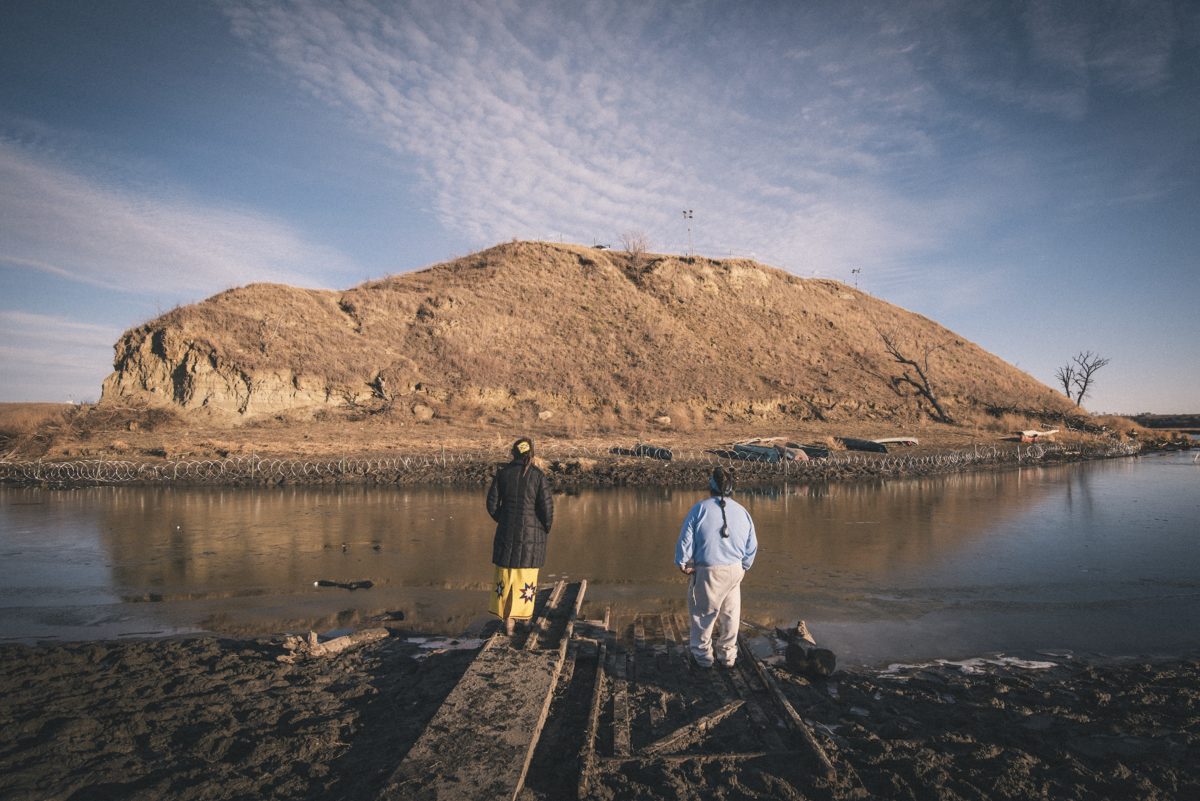
In 2016, the Dakota Access Pipeline protest at Standing Rock Sioux Reservation was thrust into the public’s sightline and, with it, discussion and debate about the politics of indigenous land rights re-ignited. Over multiple visits to Standing Rock, with the intent to document the struggle, I witnessed thousands of people—from all races and cultures—gathering in support of the Lakota people and their land rights. I saw outsiders running into new values in a camp structured around indigenous priorities. White Americans found themselves in the minority, many for the first time. In turn, they caught a glimpse of the world from Native eyes. At Standing Rock, the mantra is “Mni Wiconi”, or “water is life”—an extension of “land gives life.”
Vic Camp is the Sundance leader of the Pine Ridge reservation. “As a Lakota, we are raised and taught that water is medicine—without water, there are no future generations. Water is sacred. Mother Earth is sacred. We feel our mother’s pain right now.”
The day before, a major confrontation between North Dakota police and Standing Rock water protectors had erupted. Dozens had been sprayed by water cannons in subzero temperatures. A woman had her arm blown apart by a concussive weapon. No one had been able to breathe due to tear gas. Despite this, everywhere I went, water protectors were gearing up with the few resources they had to go back out. That was the unyielding attitude that I encountered in every Sioux, from an 18-year-old boy to a 90-year-old grandmother. The water protectors would not back down.
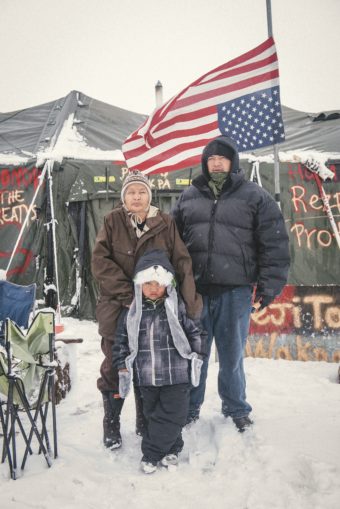
In the eyes of the Sioux there is no choice but to fight and protect the land. The daily struggle at Standing Rock turned this idea into reality for supporters. It’s easy to write off the protestors as having nothing to lose, but from the Sioux perspective, the opposite is true. They have everything to lose if they lose the land and water, for land is life and water is life.
For some, the world is deeply split along cultural lines. Some believe the culture of living close to the land is a privilege we can no longer afford. Like spoiled children that have broken all our own toys, both sides believe they deserve the remaining toys.
Perhaps the answer to our current strife is front and center. Let us remove our cultural blinders and take a moment to look through the eyes of the indigenous. Native cultures have been sustainably managing their environments longer than the industrial cultures of America, Europe, or China. The ancestors of the Kalahari San people have lived in South Africa for as long as humans have existed—over 200,000 years. We have, in less than 3,000 years, colonized the globe, razed its forests, and overfished its seas. We are even on track to cause our own extinction through climate change and overpopulation.
We cannot fight over what might have been. Everyone is suffering from the neglect of the land, the water, the plants and the animals. Our very existence as people depends on something as simple as asking, “What would an Iñupiat do?”
Related Stories
New Summer Issue of Coast Mountain Culture Days Away
It's at the printer getting printed, and we can't wait to drop our first ever summer edition, the Versus Issue. Stay…
BKYRD
Super cool mini snowboard film shot in and around the Nelson, BC area. Nice job Michael Von Berrigan and friends. We…


